Crazing Initiation and Growth in Polymethyl Methacrylate under Effects of Alcohol and Stress
Abstract
:1. Introduction
2. Materials and Experiments
2.1. Materials
2.2. Experiments
3. Results and Discussion
3.1. Effect of Solvent Atmosphere on Crazing Growth
3.1.1. Effect of Solvent Atmosphere on Crazing Initiation without Tensile Stress
3.1.2. Effect of Solvent Atmosphere on Crazing Initiation with Tensile Stress
3.2. Effect of Concentrated Stress on Crazing Initiation
3.3. Effects of Concentrated Stress and Solvent Atmosphere on PMMA Crazing Initiation
4. Conclusions
- Physical diffusion causes swelling points on the surface of PMMA due to the effect of the solvent atmosphere. Regular PMMA surface swelling points are distributed in 1–3 μm spots, whereas oriented PMMA surface swelling points are distributed in 20–40 μm strips. At the swelling points, concentration and stress gradients arise; this increases the growth rate of the crazing tip and reduces the stress on PMMA against crazing.
- Machining primarily affects the growth of crazing through residual stress. The application of tensile stress leads to localized plastic deformation around areas of concentrated stress, resulting in the formation of micro-cavities. These micro-cavities eventually merge to form crazing.
- The tip of the crazing in regular PMMA severely bends due to the uneven distribution of molecular chains. Orientated PMMA, however, can effectively alleviate the residual stress that is caused by machining through directional stretching. The direction of tensile stress is always perpendicular to the direction of crazing growth.
- The critical stress threshold for PMMA crazing is diminished by both machining and exposure to solvent atmospheres. On average, the initiation stress of crazing was reduced by 20%, and the sensitivity of crazing to stress was elevated by 0.35–0.45 mm/MPa.
Author Contributions
Funding
Institutional Review Board Statement
Data Availability Statement
Conflicts of Interest
References
- Katti, K.S. Biomaterials in Total Joint Replacement. Colloids Surf. B Biointerfaces 2004, 39, 133–142. [Google Scholar] [CrossRef] [PubMed]
- Wu, C.; Jin, Z.; Wang, H.; Ma, H.; Wang, Y. Design and Fabrication of a Nanofluidic Channel by Selective Thermal Oxidation and Etching Back of Silicon Dioxide Made on a Silicon Substrate. J. Micromechanics Microeng. 2007, 17, 2393–2397. [Google Scholar] [CrossRef]
- Ramakrishna, S.; Mayer, J.; Wintermantel, E.; Leong, K.W. Biomedical applications of polymer-composite materials: A review. Compos. Sci. Technol. 2001, 61, 1189–1224. [Google Scholar] [CrossRef]
- Zaghloul, M.Y.; Zaghloul, M.M.Y.; Zaghloul, M.M.Y. Influence of Stress Level and Fibre Volume Fraction on Fatigue Performance of Glass Fibre-Reinforced Polyester Composites. Polymers 2022, 14, 2662. [Google Scholar] [CrossRef]
- Zaghloul, M.M.Y.; Zaghloul, M.Y.M.; Zaghloul, M.M.Y. Experimental and Modeling Analysis of Mechanical-Electrical Behaviors of Polypropylene Composites Filled with Graphite and MWCNT Fillers. Polym. Test 2017, 63, 467–474. [Google Scholar] [CrossRef]
- Nabhan, A.; Taha, M.; Ghazaly, N.M. Filler Loading Effect of Al2O3/TiO2 Nanoparticles on Physical and Mechanical Characteristics of Dental Base Composite (PMMA). Polym. Test 2023, 117, 107848. [Google Scholar] [CrossRef]
- Berger, L.L.; Kramer, E.J. The Effect of Temperature on the Transition from Crazing to Shear Deformation in Crosslinked Polystyrene. J. Mater. Sci. 1988, 23, 3536–3543. [Google Scholar] [CrossRef]
- Khoshaim, A.B.; Elsheikh, A.H.; Moustafa, E.B.; Basha, M.; Showaib, E.A. Experimental Investigation on Laser Cutting of PMMA Sheets: Effects of Process Factors on Kerf Characteristics. J. Mater. Res. Technol. 2021, 11, 235–246. [Google Scholar] [CrossRef]
- Hoogenboom, R.; Becer, C.R.; Guerrero-Sanchez, C.; Hoeppener, S.; Schubert, U.S. Solubility and thermoresponsiveness of PMMA in alcohol-water solvent mixtures. Aust. J. Chem. 2010, 63, 1173–1178. [Google Scholar] [CrossRef]
- Kambour, R.P. Mechanism of Fracture in Glassy Polymers. III. Direct Observation of the Craze Ahead of the Propagating Crack in Poly(Methyl Methacrylate) and Polystyrene. J. Polym. Sci. Part A-2 Polym. Phys. 1966, 4, 349–358. [Google Scholar] [CrossRef]
- Kramer, E.J.; Krenz, H.G.; Ast, D.G. Mechanical Properties of Methanol Crazes in Poly(Methyl Methacrylate). J. Polym. Sci. Polym. Phys. Ed. 1978, 16, 349–366. [Google Scholar] [CrossRef]
- Andrews, E.H.; Levy, G.M.; Willis, J. Environmental crazing in a glassy polymer: The role of solvent absorption. J. Mater. Sci. 1973, 8, 1000–1008. [Google Scholar] [CrossRef]
- Kramer, E.J.; Bubeck, R.A. Growth Kinetics of Solvent Crazes in Glassy Polymers. J. Polym. Sci. Polym. Phys. Ed. 1978, 16, 1195–1217. [Google Scholar] [CrossRef]
- Thomas, N.L.; Windle, A.H. Diffusion mechanics of the system PMMA-methanol. Polymer 1981, 22, 627–639. [Google Scholar] [CrossRef]
- Luo, W.; Yang, T.; Zhang, P. Research Progress on meso damage evolution of polymers. Prog. Mech. 2001, 31, 264–275. [Google Scholar]
- Thuy, M.; Pedragosa-Rincón, M.; Niebergall, U.; Oehler, H.; Alig, I.; Böhning, M. Environmental Stress Cracking of High-Density Polyethylene Applying Linear Elastic Fracture Mechanics. Polymers 2022, 14, 2415. [Google Scholar] [CrossRef]
- Yildirim, F.F.; Sezer Hicyilmaz, A.; Yildirim, K. The Effects of the Weathering Methods on the Properties of the ABS, ASA and PMMA Polymers. Polym. Test 2022, 107, 107484. [Google Scholar] [CrossRef]
- Razavi, M.; Cheng, S.; Huang, D.; Zhang, S.; Wang, S.Q. Crazing and yielding in glassy polymers of high molecular weight. Polymer. 2020, 197, 122445. [Google Scholar] [CrossRef]
- Michler, G.H. Correlation between craze formation and mechanical behaviour of amorphous polymers. J. Mater. Sci. 1990, 25, 2321–2334. [Google Scholar] [CrossRef]
- Gao, G.; Xing, Y. Monitoring the evolution of crazing damage in an area under stress concentration via acoustic emission. Int. J. Precis. Eng. Manuf. 2018, 19, 561–568. [Google Scholar] [CrossRef]
- Wang, Y.; Yu, B.; Wu, H.; Lu, K.; Wang, D. Dynamic Crack Growth Characteristics of Half-Circular Disk PMMA Specimens with Prefabricated Penetration Defects under Impact Loading. Polym. Test 2020, 91, 106684. [Google Scholar] [CrossRef]
- Krenz, H.G.; Ast, D.G.; Kramer, E.J. Micromechanics of Solvent Polystyrene Crazes in Polystyrene. J. Mater. Sci. 1976, 11, 2198–2210. [Google Scholar] [CrossRef]
- Wang, Y.; Wang, S.; Liu, K.; Gan, Y.; Han, L.; Jiang, S. Effect of Indirect Cryogenic Cooling on the Machining Accuracy and Tool Vibration in the Turning of Polysulfone. J. Manuf. Sci. Eng. 2021, 144, 061004. [Google Scholar] [CrossRef]
- Lang, R.W.; Manson, J.A.; Hertzberg, R.W.; Schirrer, R. Craze development in poly (methyl methacrylate) during stable fatigue crack propagation. Polym. Eng. Sci. 1984, 24, 833–842. [Google Scholar] [CrossRef]
- Jie, M.; Li, Y.; Deng, Z. Crazing damage field at crack tip of amorphous polymer. J. Appl. Mech. 1998, 15, 7–12. [Google Scholar]
- Argon, A.S. Physical Basis of Distortional and Dilational Plastic Flow in Glassy Polymers. J. Macromol. Sci. Part B 1973, 8, 573–596. [Google Scholar] [CrossRef]
- Socrate, S.; Boyce, M.C.; Lazzeri, A. A micromechanical model for multiple crazing in high impact polystyrene. Mech. Mater. 2001, 33, 155–175. [Google Scholar] [CrossRef]
- Wu, Z.; Zhang, B. Molecular dynamics simulation of polymer crazing at different strain rates. Polym. Mater. Sci. Eng. 2012, 28, 169–172. [Google Scholar]
- Zhai, G.; Ding, Y.; Ma, Z.; Wei, Z.; Li, X.; Liu, B. Novel Triaxial Experimental Investigation on Compressive Behavior of Hollow Glass Microspheres Composites under Varied Temperature Environments. Polym. Test 2022, 115, 107745. [Google Scholar] [CrossRef]
- Wang, X.K.; Wei, S.C.; Xu, B.S.; Chen, Y.; Yan, X.; Xia, H.H. Transparent organic materials of aircraft cockpit canopies: Research status and development trends. Mater. Res. Innov. 2015, 19 (Suppl. 10), S10-199–S10-206. [Google Scholar] [CrossRef]
- Thirumalai, R.; Senthilkumaar, J.S.; Selvarani, P.; Ramesh, S. Machining Characteristics of Inconel 718 under Several Cutting Conditions Based on Taguchi Method. Proc. Instig. Mech. Eng. C J. Mech. Eng. Sci. 2013, 227, 1889–1897. [Google Scholar] [CrossRef]
- Iisaka, K.; Hayama, M.; Fukami, A. Dependence of Solvent Crazing in Bisphenol—A Polycarbonate on Molecular Weight of Organic Liquids. J. Macromol. Sci. Part B 1988, 27, 385–405. [Google Scholar] [CrossRef]
- Ntal Erate, Q.A.; Brown, H.R.; Kramer, E.J. Effect of Surface Tension on the Stress in Effect of Surface Tension on the Stress in Environmental Crazes. Polymer 1981, 22, 687–690. [Google Scholar]
- Kausch, H.H.; Dettenmaier, M. Polymer Bulletin Some Molecular Aspects of Craze Formation. Polym. Bull. 1980, 3, 565–570. [Google Scholar] [CrossRef]
- Donald, A.M.; Kramer, E.J. Effect of Molecular Entanglements on Craze Microstructure in Glassy Polymers. J. Polym. Sci. Part A-2 Polym. Phys. 1982, 20, 899–909. [Google Scholar] [CrossRef]
- Kramer, E.J. Micromechanical Measurements of Polymers by Transmission Electron Microscopy; ACS Publications: Philadelphia, PA, USA, 1983. [Google Scholar]
- Aegon, A.S.; Hannoosh, J.G. Initiation of Crazes in Polystyrene. Philos. Mag. 1977, 36, 1195–1216. [Google Scholar] [CrossRef]
- Bucknall, C.B. New Criterion for Craze Initiation. Polymer 2007, 48, 1030–1041. [Google Scholar] [CrossRef]
- Saad-Gouider, N.; Estevez, R.; Olagnon, C.; Séguéla, R. Calibration of a Viscoplastic Cohesive Zone for Crazing in PMMA. Eng. Fract. Mech. 2006, 73, 2503–2522. [Google Scholar] [CrossRef]
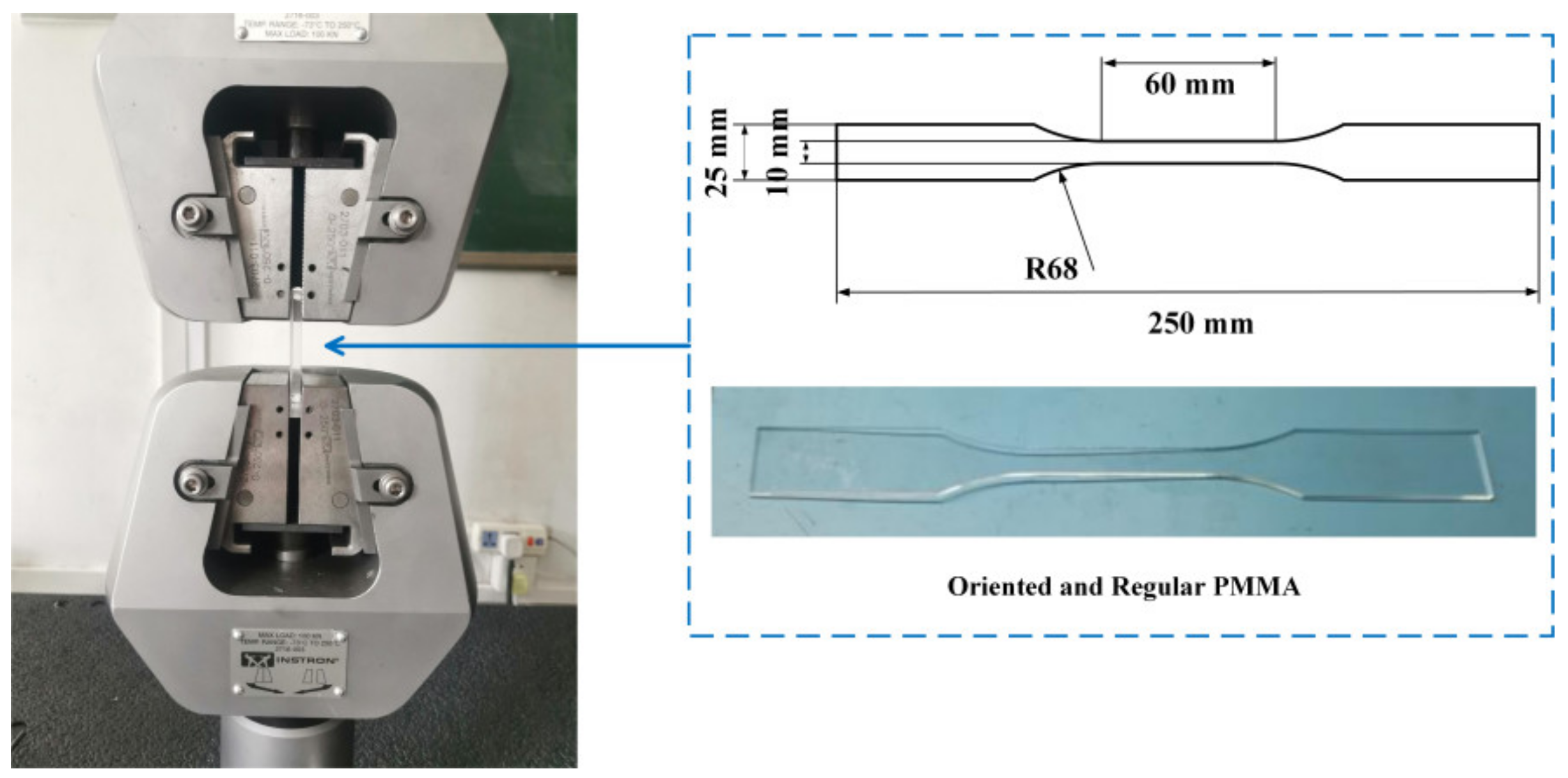
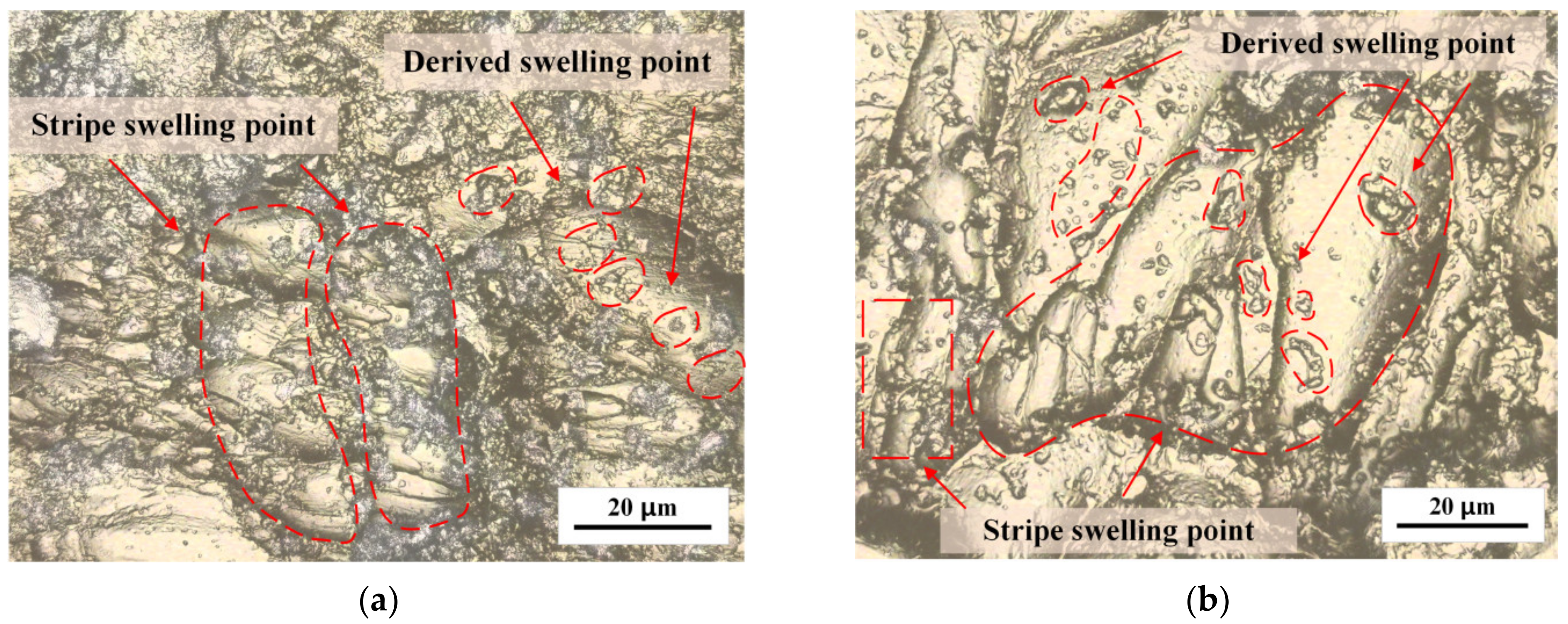

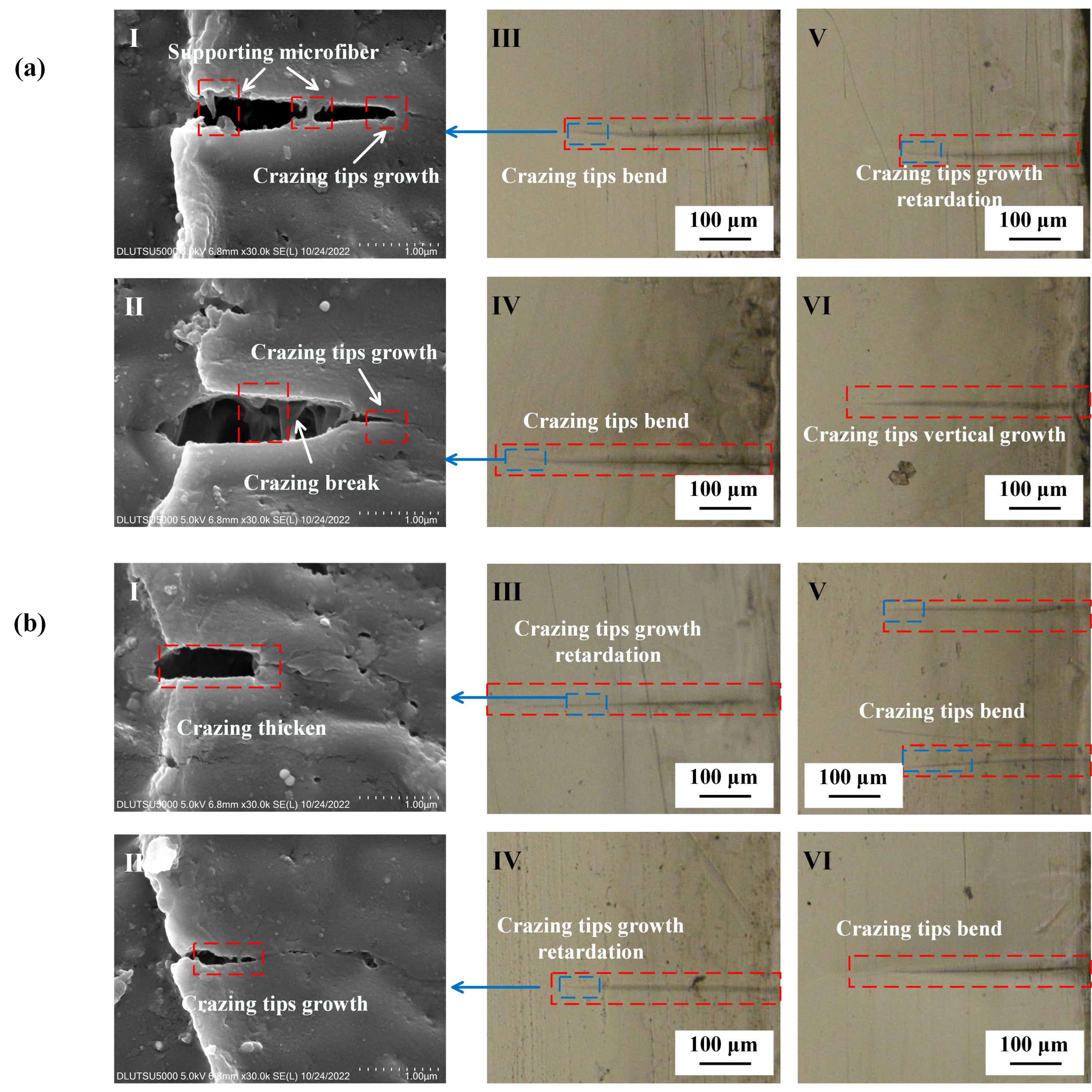

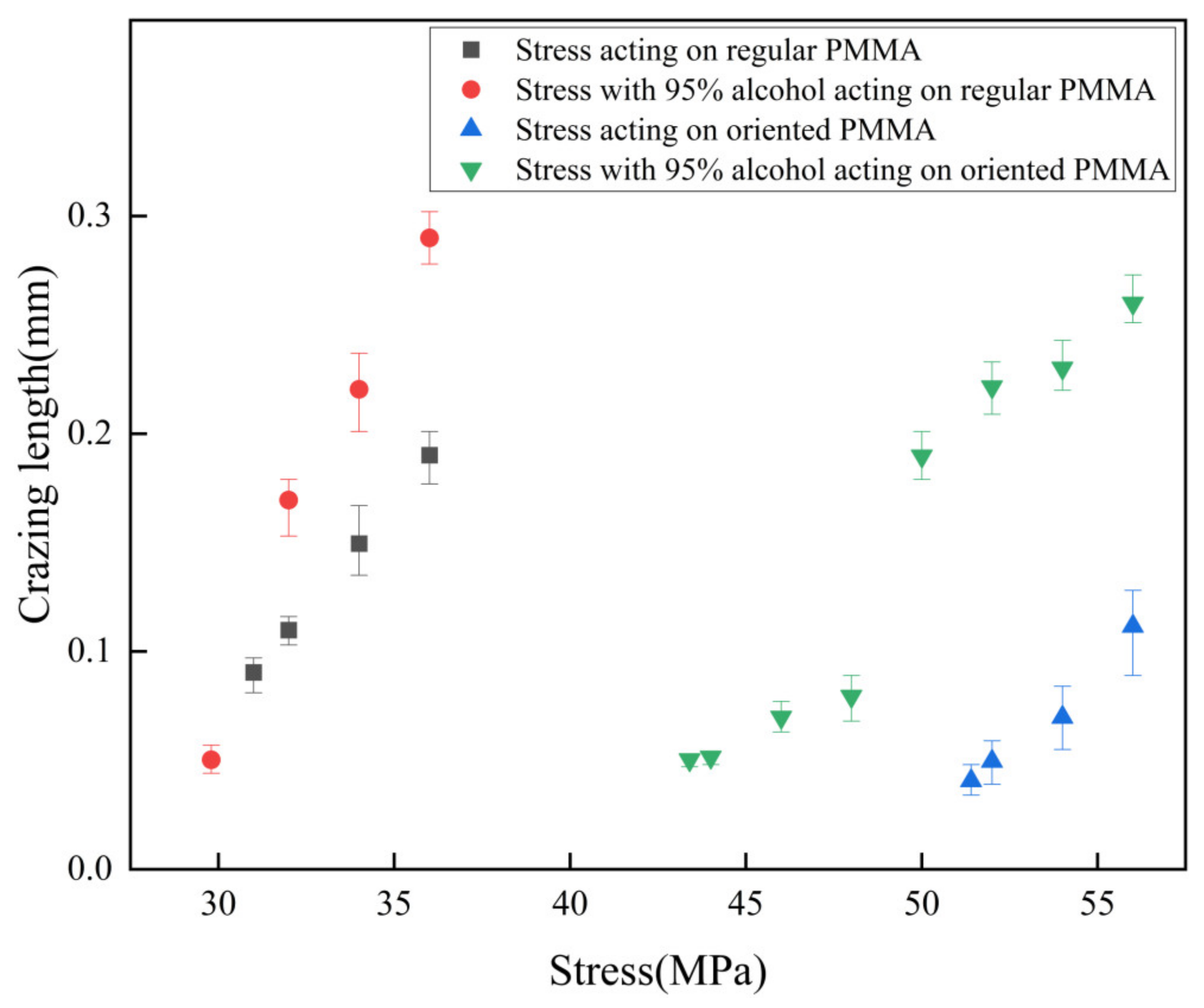
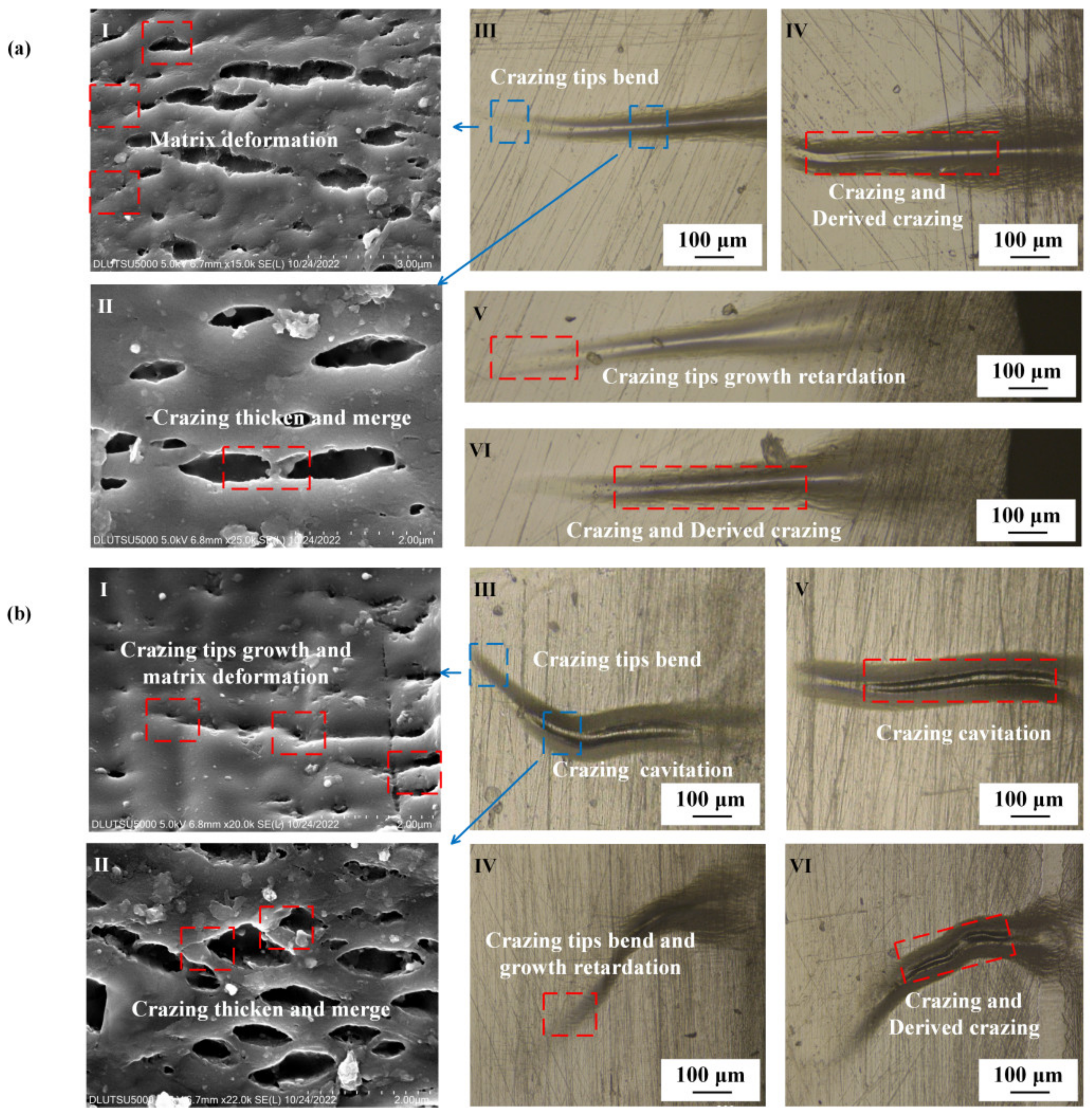

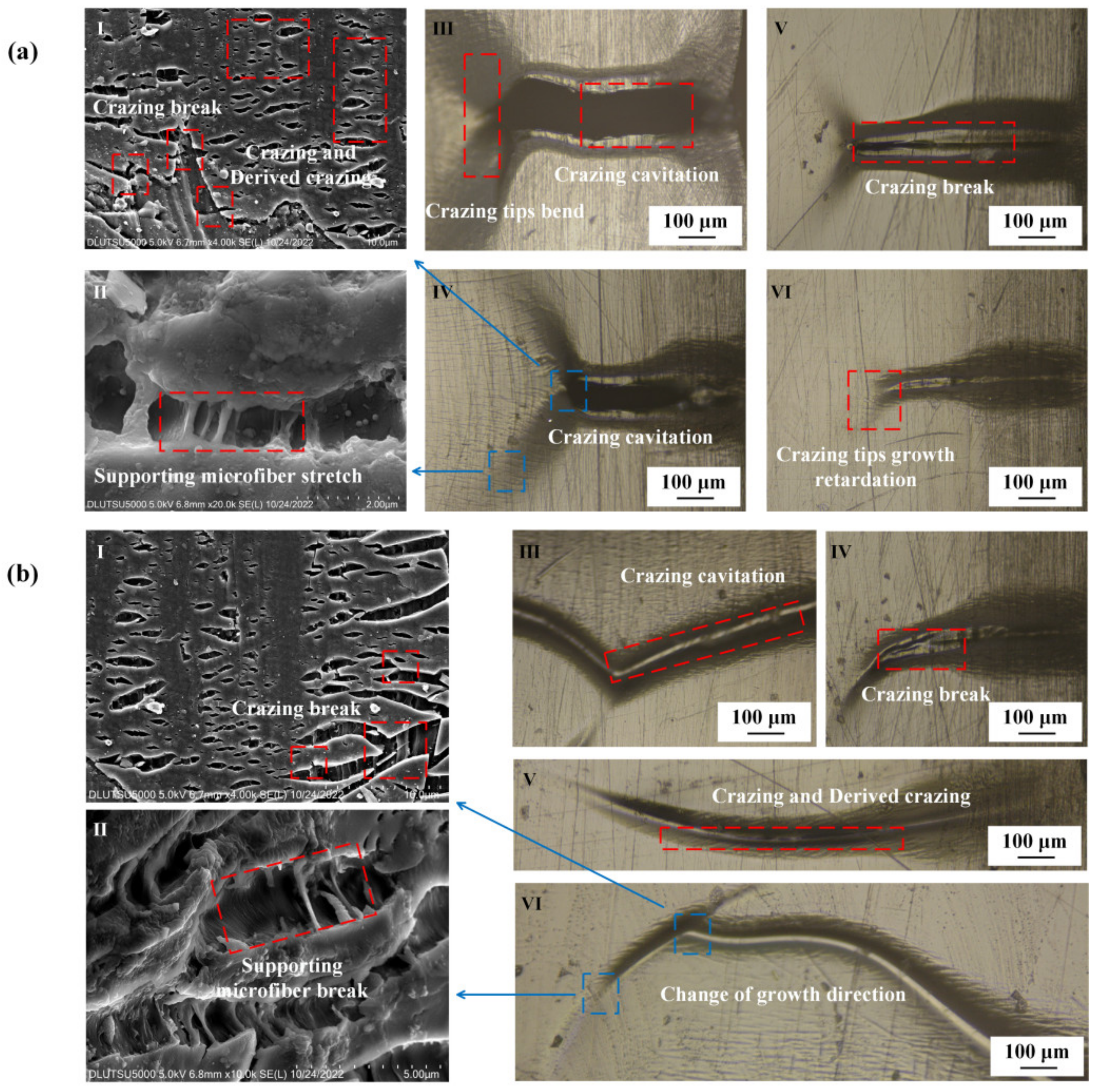

| Property | Regular PMMA | Oriented PMMA |
|---|---|---|
| Tensile Strength at 23 °C (MPa) | 77.8 | 94.6 |
| Tensile Strength at 100 °C (MPa) | 1.84 | 28.4 |
| Bending strength (MPa) | 130 | >205 |
| Impact strength (kJm–2) | 22.6 | 57.0 |
| Break elongation (%) | 4.0 | 7.7 |
| Group No. | Material | Machining | Solvent | Load |
|---|---|---|---|---|
| Group 1 | regular PMMA | Non-milling | 95% alcohol by volume | Standing |
| Group 2 | oriented PMMA | Non-milling | 95% alcohol by volume | Standing |
| Group 3 | regular PMMA | Non-milling | Air | Uniaxial tension |
| Group 4 | oriented PMMA | Non-milling | 95% alcohol by volume | Uniaxial tension |
| Group 5 | regular PMMA | Milling | 95% alcohol by volume | Standing |
| Group 6 | oriented PMMA | Milling | 95% alcohol by volume | Standing |
| Group 7 | regular PMMA | Milling | Air | Uniaxial tension |
| Group 8 | regular PMMA | Milling | 75% alcohol by volume | Uniaxial tension |
| Group 9 | regular PMMA | Milling | 95% alcohol by volume | Uniaxial tension |
| Group 10 | oriented PMMA | Milling | Air | Uniaxial tension |
| Group 11 | oriented PMMA | Milling | 75% alcohol by volume | Uniaxial tension |
| Group 12 | oriented PMMA | Milling | 95% alcohol by volume | Uniaxial tension |
| Materials and Treatment | Stress at Crazing | Sensitivity of Crazing to Stress |
|---|---|---|
| Regular PMMA | 31.4 MPa | 0.02 mm/MPa |
| Regular PMMA with 95% alcohol | 29.8 MPa | 0.049 mm/MPa |
| Oriented PMMA | 51.4 MPa | 0.015 mm/MPa |
| Oriented PMMA with 95% alcohol | 43.4 MPa | 0.055 mm/MPa |
| Materials and Treatment | Stress at Crazing | Sensitivity of Crazing to Stress |
|---|---|---|
| Regular PMMA | 31.4 MPa | 0.02 mm/MPa |
| Regular PMMA after milling | 26.8 MPa | 0.065 mm/MPa |
| Oriented PMMA | 51.4 MPa | 0.015 mm/MPa |
| Oriented PMMA after milling | 42.2 MPa | 0.04 mm/MPa |
| Material and Treatment | Stress at Crazing | Sensitivity of Crazing to Stress |
|---|---|---|
| Oriented PMMA | 42.2 MPa | 0.02 mm/MPa |
| Oriented PMMA with 75% alcohol | 31.8 MPa | 0.035 mm/MPa |
| Oriented PMMA with 95% alcohol | 31.4 MPa | 0.055 mm/MPa |
| Regular PMMA | 26.8 MPa | 0.065 mm/MPa |
| Regular PMMA with 75% alcohol | 23.4 MPa | 0.077 mm/MPa |
| Regular PMMA with 95% alcohol | 22.8 MPa | 0.12 mm/MPa |
Disclaimer/Publisher’s Note: The statements, opinions and data contained in all publications are solely those of the individual author(s) and contributor(s) and not of MDPI and/or the editor(s). MDPI and/or the editor(s) disclaim responsibility for any injury to people or property resulting from any ideas, methods, instructions or products referred to in the content. |
© 2023 by the authors. Licensee MDPI, Basel, Switzerland. This article is an open access article distributed under the terms and conditions of the Creative Commons Attribution (CC BY) license (https://creativecommons.org/licenses/by/4.0/).
Share and Cite
Yan, Y.; Sun, Y.; Su, J.; Li, B.; Zhou, P. Crazing Initiation and Growth in Polymethyl Methacrylate under Effects of Alcohol and Stress. Polymers 2023, 15, 1375. https://doi.org/10.3390/polym15061375
Yan Y, Sun Y, Su J, Li B, Zhou P. Crazing Initiation and Growth in Polymethyl Methacrylate under Effects of Alcohol and Stress. Polymers. 2023; 15(6):1375. https://doi.org/10.3390/polym15061375
Chicago/Turabian StyleYan, Ying, Yujia Sun, Jiyang Su, Bo Li, and Ping Zhou. 2023. "Crazing Initiation and Growth in Polymethyl Methacrylate under Effects of Alcohol and Stress" Polymers 15, no. 6: 1375. https://doi.org/10.3390/polym15061375
APA StyleYan, Y., Sun, Y., Su, J., Li, B., & Zhou, P. (2023). Crazing Initiation and Growth in Polymethyl Methacrylate under Effects of Alcohol and Stress. Polymers, 15(6), 1375. https://doi.org/10.3390/polym15061375









